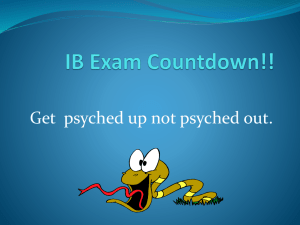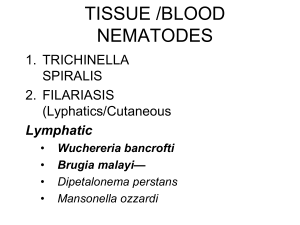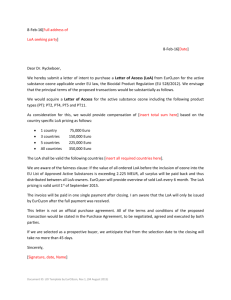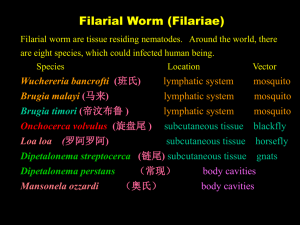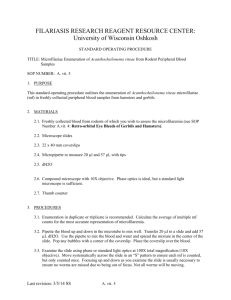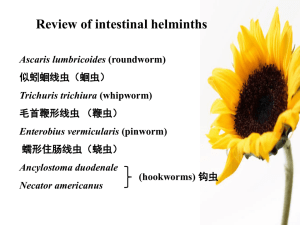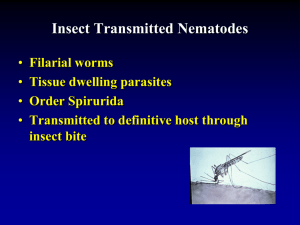Volume 24 - No 9: Loa loa
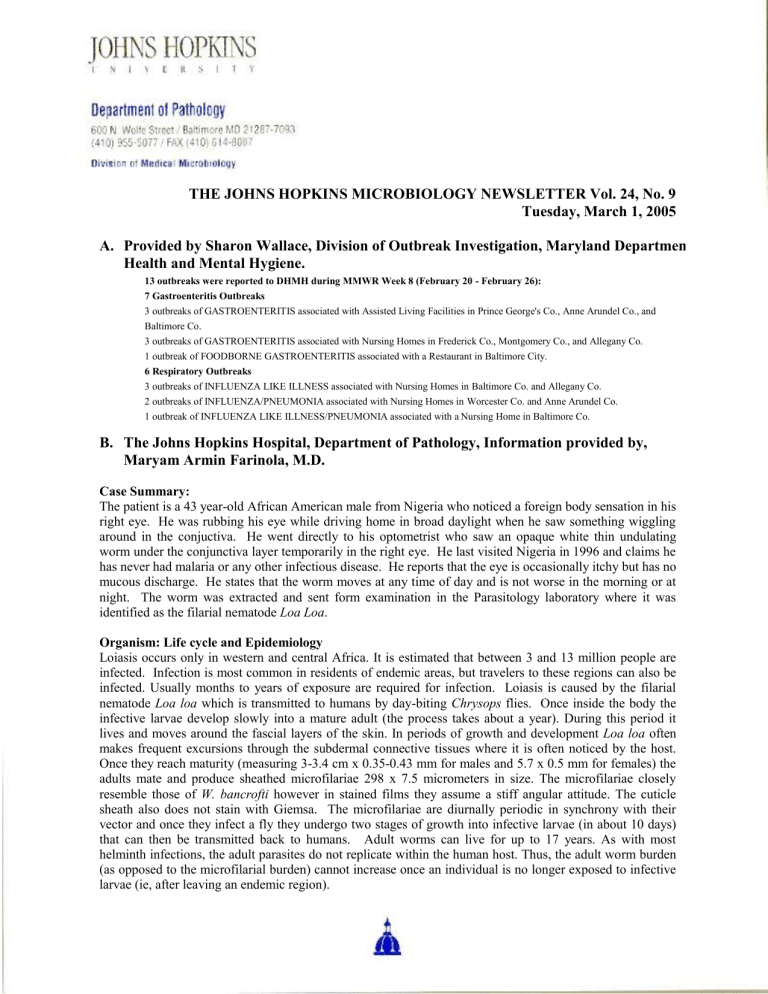
THE JOHNS HOPKINS MICROBIOLOGY NEWSLETTER Vol. 24, No. 9
Tuesday, March 1, 2005
A. Provided by Sharon Wallace, Division of Outbreak Investigation, Maryland Department of
Health and Mental Hygiene.
13 outbreaks were reported to DHMH during MMWR Week 8 (February 20 - February 26):
7 Gastroenteritis Outbreaks
3 outbreaks of GASTROENTERITIS associated with Assisted Living Facilities in Prince George's Co., Anne Arundel Co., and
Baltimore Co.
3 outbreaks of GASTROENTERITIS associated with Nursing Homes in Frederick Co., Montgomery Co., and Allegany Co.
1 outbreak of FOODBORNE GASTROENTERITIS associated with a Restaurant in Baltimore City.
6 Respiratory Outbreaks
3 outbreaks of INFLUENZA LIKE ILLNESS associated with Nursing Homes in Baltimore Co. and Allegany Co.
2 outbreaks of INFLUENZA/PNEUMONIA associated with Nursing Homes in Worcester Co. and Anne Arundel Co.
1 outbreak of INFLUENZA LIKE ILLNESS/PNEUMONIA associated with a Nursing Home in Baltimore Co.
B. The Johns Hopkins Hospital, Department of Pathology, Information provided by,
Maryam Armin Farinola, M.D.
Case Summary:
The patient is a 43 year-old African American male from Nigeria who noticed a foreign body sensation in his right eye. He was rubbing his eye while driving home in broad daylight when he saw something wiggling around in the conjuctiva. He went directly to his optometrist who saw an opaque white thin undulating worm under the conjunctiva layer temporarily in the right eye. He last visited Nigeria in 1996 and claims he has never had malaria or any other infectious disease. He reports that the eye is occasionally itchy but has no mucous discharge. He states that the worm moves at any time of day and is not worse in the morning or at night. The worm was extracted and sent form examination in the Parasitology laboratory where it was identified as the filarial nematode Loa Loa .
Organism: Life cycle and Epidemiology
Loiasis occurs only in western and central Africa. It is estimated that between 3 and 13 million people are infected. Infection is most common in residents of endemic areas, but travelers to these regions can also be infected. Usually months to years of exposure are required for infection. Loiasis is caused by the filarial nematode Loa loa which is transmitted to humans by day-biting Chrysops flies. Once inside the body the infective larvae develop slowly into a mature adult (the process takes about a year). During this period it lives and moves around the fascial layers of the skin. In periods of growth and development Loa loa often makes frequent excursions through the subdermal connective tissues where it is often noticed by the host.
Once they reach maturity (measuring 3-3.4 cm x 0.35-0.43 mm for males and 5.7 x 0.5 mm for females) the adults mate and produce sheathed microfilariae 298 x 7.5 micrometers in size. The microfilariae closely resemble those of W. bancrofti however in stained films they assume a stiff angular attitude. The cuticle sheath also does not stain with Giemsa. The microfilariae are diurnally periodic in synchrony with their vector and once they infect a fly they undergo two stages of growth into infective larvae (in about 10 days) that can then be transmitted back to humans.
Adult worms can live for up to 17 years. As with most helminth infections, the adult parasites do not replicate within the human host. Thus, the adult worm burden
(as opposed to the microfilarial burden) cannot increase once an individual is no longer exposed to infective larvae (ie, after leaving an endemic region).
Test procedure and instructions:
Clinical Significance:
Most people infected with L. loa are asymptomatic. The two classic clinical presentations of loiasis are localized subcutaneous swellings that transiently appear and are known as Calabar swellings, or the pathognomonic migration of the adult worm across the eye. When the adult worm migrates to the eye, it crawls beneath the conjunctiva, causing transient conjunctival inflammation and edema. The adult worm usually measures 3 to 7 cm by 0.3 to 0.5 mm and typically migrates at the rate of 1 cm per minute. The worm is often directly visible as it cross the conjunctiva, which usually takes approximately 10 to 20 minutes. Spontaneous resolution of symptoms occurs after the worm has left the eye, and there are usually no sequelae. Calabar swellings are due to transient angioedema related to hypersensitivity reactions to the adult parasite migrating through the subcutaneous tissue and/or to released microfilariae. They can occur anywhere on the body but are most frequent on the face and extremities. The swelling is often preceded by local pain or itching. Typical Calabar swellings are non-erythematous and measure 5 to 20 cm in diameter. They can extend into nearby joints or peripheral nerves. They usually resolve spontaneously after two to four days but occasionally last for several weeks. Recurrences can develop at the same site or elsewhere.
Laboratory diagnosis
Nonspecific but characteristic laboratory abnormalities include a high eosinophil count, often
>3000/µL (normal <500/µL). Hypergammaglobulinemia and a high level of IgE are often present.
Loiasis can be definitively diagnosed by extracting a migrating adult worm from the subcutaneous tissue or from the conjunctivae, or by detecting microfilariae in a blood smear. L. loa typically has diurnal periodicity, meaning that the microfilariae are more abundant in the bloodstream during the day than at night. This coincides with the feeding pattern of the vector, thereby potentiating transmission of infection. This diurnal periodicity differentiates microfilariae in loiasis from
Bancroftian and Brugian filariasis. However, this pattern can be reversed by changing by the patient's sleep-wake cycle. The microfilariae of L. loa have a distinct morphology, which also differentiates them from other blood microfilariae. In loiasis, the microfilariae are sheathed and have prominent nuclei that extend all the way to tip of the tail.
Treatment:
The treatment of choice for loiasis is Diethylcarbamazine (DEC), a piperazine derivative. DEC has activity against both microfilariae and adult worms in loiasis. Therefore, a sustained decrease in microfilarial intensity occurs following treatment. Patients with high loads of L. loa microfilariae may experience adverse events following treatment with DEC due to rapid killing of the microfilariae.
Although reactions are not common, they can be serious and can include shock and encephalitis. For this reason, it is recommended that individuals with high levels of circulating microfilariae (>2500 to
3000 microfilariae per mL of blood) should either have no treatment if they are asymptomatic, or should undergo cytapheresis prior to therapy to remove part of their microfilarial burden.
Alternatively, administration of steroids (1 mg/kg per day of prednisolone) for the first three days of
DEC treatment can be considered. An alternative potential therapy for loiasis is albendazole. It does not have a microfilaricidal effect in L. loa infections, but instead has a partial macrofilaricidal effect, causing death or sterilization of the adult worm. A gradual decrease in microfilariae levels over several months results. Surgical removal of worms from the eye or from the skin can also be performed. However, this is usually not a practical method for cure of infection, particularly in endemic areas, because of the large worm burden that is typically present. Surgical removal also is not necessary clinically since transconjunctival migration of the worm does not result in ocular damage.
References:
1.
http://www.cdc.gov/dpdx
2.
http://www.uptodate.com
3.
Koneman EW, et al. Diagnostic Mircrobiology. 5 th edition. Lippincott. 1997; 1132-1136.
4.
Pinder M. Loa loa – a neglected filarial. Parasitol Today 1988: 4(10): 279-84.
5.
Vande W. Chemotherapy of filariases. Parasitol Today 1991: 7(8): 194-9.

